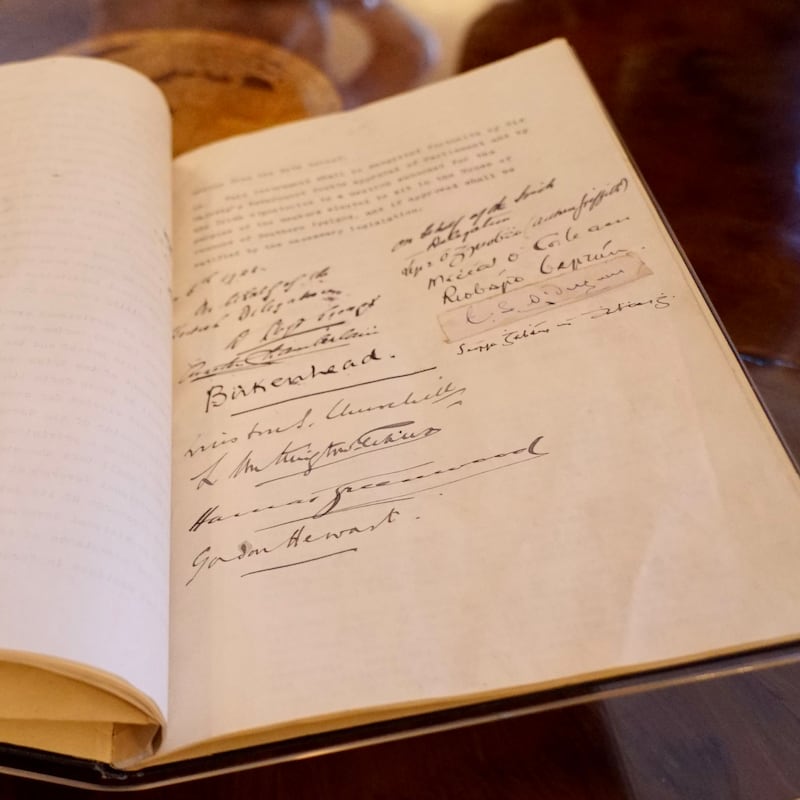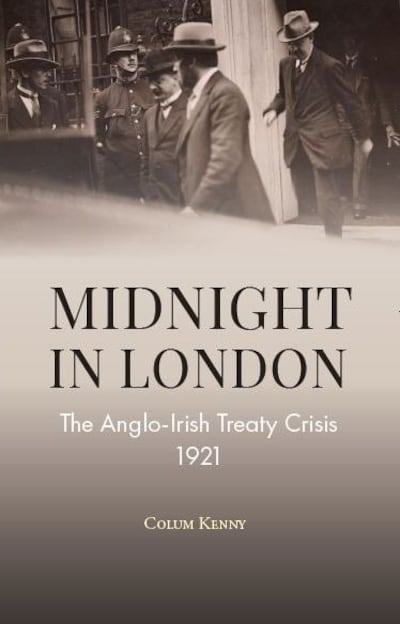The talks that led up to the signing of the Anglo-Irish Treaty in London on December 6th, 1921, were long and gruelling. And the Dáil debates that followed into January 1922 were bitter and bruising.
When Arthur Griffith and Michael Collins died prematurely, in 1922, false ideas of what actually had happened during treaty negotiations easily flourished. In my latest book I try to dispel some of them. They include the following half-dozen.
Six myths about the Anglo-Irish Treaty of 1921
1. Michael Collins led the team in London
It is remarkable how often the impression is given in popular accounts, on TV or elsewhere, and frequently sometimes by omission, that Collins led the negotiations. He was of course a key participant, albeit reluctantly, but Griffith was chairman. Collins deferred to and respected him.
2. The Treaty partitioned Ireland
In popular discussions it is often asserted that the Treaty somehow created the Border. But the British had already divided Ireland by the Government of Ireland Act 1920, and Northern Ireland's parliament was already elected and sitting even before a truce was declared in July 1921. Indeed, de Valera told the Dáil in autumn 1921 that Ulster counties could vote themselves out of any republic.
3. Arthur Griffith made a secret deal
There is a belief that Arthur Griffith made Prime Minister David Lloyd George some kind of secret commitment on the Border about halfway through negotiations, in early November 1921. This notion is kept afloat in various and sometimes contradictory ways, and is perpetuated especially by writers who rely directly or indirectly on Frank Pakenham's 1935 volume Peace by Ordeal and on an ambiguous note by Robert Barton.
Pakenham’s book has contributed largely to Griffith’s response to a certain vital British memo being misconstrued, if not misrepresented, as if Griffith somehow agreed to its content. In fact, as he reported to de Valera at the time, Griffith explicitly reserved his position on the proposal in it relating to Northern Ireland and also told the British that he could not bind his colleagues ahead of fuller discussions. In any event, the proposal in that memo was soon incorporated into a document considered by all members of the Irish cabinet before the agreement was signed. I consider what really happened at some length in my recent book, Midnight in London: The Anglo-Irish Treaty Crisis 1921.

4. Griffith's team broke a promise not to accept an "oath of allegiance" to the king
The wording of the proposed oath was in fact changed shortly before the agreement was signed, as part of a final deal that also yielded the new State a large measure of financial and economic autonomy. The oath of allegiance to the king was replaced by an oath of faithfulness. One may argue that there was no great difference – and some did so – but what one cannot do, unless seeking to make a damning point falsely, is to refer to an "oath of allegiance" to the king being agreed.
5. The team in London actually "signed the Treaty" and so locked Ireland into it
While some delegates themselves used that shorthand expression it is important to bear in mind that what they then signed was just an agreement for a treaty, and was conditional upon approval by a majority of members of Dáil Éireann before becoming law. This is not just a legal point. By portraying Griffith as having somehow signed away ultimate republican ambitions, his detractors could distract from the fact that the agreement was subsequently approved in short order by the Irish cabinet, Dáil Éireann and the 26-county electorate.
6. The five delegates were divided when it came to signing the agreement and proposing it in Dáil Éireann
In fact they were unanimous, even if each had reservations to various degrees and disagreed with each other on aspects of the deal. The agriculturalist Robert Barton and solicitor George Gavan Duffy might strike a pose in public that seemed more reluctant or more republican that that of the founder of Sinn Féin Arthur Griffith or the leading militant Michael Collins, but in the end they went along with the deal to avoid a new war.

As Gavan Duffy told the Dáil on December 21st, 1921, "I am going to recommend this Treaty to you very reluctantly, but very sincerely, because I see no alternative". Barton said that he had broken his oath of allegiance to the Republic when he signed the agreement, but did so "because I judged that violation to be the lesser of alternative outrages forced upon me, and between which I was compelled to chose". The greater outrage was a return to war with Britain and possible military defeat and devastation. Having originally supported de Valera's decision not to lead the team in London, Barton had lately pleaded with Dev to come to Downing Street – but his plea fell on deaf ears.
Midnight in London: The Anglo-Irish Treaty Crisis 1921, by Colum Kenny, is published by Eastwood Books (€9.99); Colum Kenny is also the author of The Enigma of Arthur Griffith: "Father of Us All", published by Merrion Press (€19.95)











